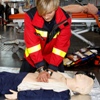
Experts Advise Auditing All Witnessed VF Collapses
Dr. Mickey S. Eisenberg, MD, Ph.D., and co-author Bruce M. Psaty, MD, Ph.D., write in the July 7 issue of JAMA that "a starting assumption is that every patient with witnessed ventricular fibrillation should survive."
Two authors writing in the new issue of JAMA advocate having EMS medical directors audit every case of ventricular fibrillation (VF) with a witnessed collapse to understand why some of those victims don't survive. "A starting assumption is that every patient with witnessed ventricular fibrillation should survive. This assumption is not unreasonable, considering that defibrillation if provided within 3 minutes of collapse can achieve a survival rate of 74% in the community. If the patient did not survive, the audit should determine why not," write Dr. Mickey S. Eisenberg, MD, Ph.D., of Seattle & King County Public Health's Division of Emergency Medical Services, and co-author Bruce M. Psaty, MD, Ph.D., of the Cardiovascular Health Research Unit, University of Washington and the Group Health Research Institute, Group Health Cooperative, in Seattle.
2010 is the 50th anniversary of the invention of CPR. While its use has saved thousands of people since 1960, outcomes remain disappointing because bystander-initiated CPR occurs in only an estimated 31 percent of out-of-hospital cardiac arrests, they write.
They say the American Heart Association's recent shift in favor of hands-only CPR will help, as will dispatcher-assisted telephone CPR. Auditing witnessed VF collapses, which they contend is likely to show a community how to raise its survival rate, is rarely done, however. "Yes, we audit every case of witnessed VF. I suspect it is done by fewer than 1 percent of communities," Eisenberg said in answer to an e-mailed question.